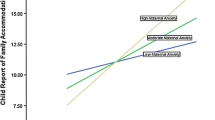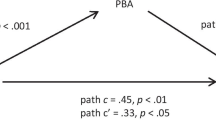Abstract
High levels of family accommodation (FA), or parental involvement in child symptoms, are associated with child anxiety symptom severity. The strength of associations has varied across studies, however, highlighting the need to identify moderating variables. We investigated whether anxiety sensitivity (AS) moderated the FA-anxiety symptom severity association in clinically anxious children (N = 103, ages 6–17; mean age 11.07 years). We collected child and mother ratings of FA, child anxiety symptom severity, and child AS ratings. AS significantly moderated the FA-child anxiety severity link. Specifically, this link was significant for low-AS but not high-AS children. Findings suggest that FA may operate in the typically observed fashion for low-AS children—alleviating immediate distress while inadvertently exacerbating longer-term anxiety—whereas high-AS children may experience distress following anxiety-provoking stimuli regardless of FA. Assessing AS in research and clinical settings may help identify subsets of children for whom FA is more closely tied to anxiety severity.


Similar content being viewed by others
References
Flessner CA, Freeman JB, Sapyta J et al (2011) Predictors of parental accommodation in pediatric obsessive–compulsive disorder: findings from the Pediatric Obsessive–Compulsive Disorder Treatment Study (POTS) Trial. J Am Acad Child Adolesc Psychiatry 50:716–725
Lebowitz ER, Woolston J, Bar-Haim Y, Calvocoressi L, Dauser C, Warnick E, Scahill L, Chakir AR, Shechner T, Hermes H, Vitulano LA (2013) Family accommodation in pediatric anxiety disorders. Depress Anxiety 30:47–54
Lebowitz ER, Panza KE, Bloch MH (2016) Family accommodation in obsessive–compulsive and anxiety disorders: a five-year update. Expert Rev Neurother 16:45–53
Thompson-Hollands J, Kerns CE, Pincus DB, Comer JS (2014) Parental accommodation of child anxiety and related symptoms: range, impact, and correlates. J Anxiety Disord 28:765–773
Lebowitz ER, Panza KE, Su J, Bloch MH (2012) Family accommodation in obsessive–compulsive disorder. Expert Rev Neurother 12:229–238
Silverman WK, Kurtines WM (1996) Anxiety and phobic disorders: a pragmatic approach. Plenum Press, New York
Storch EA, Larson MJ, Muroff J, Caporino N, Geller D, Reid JM, Morgan J, Jordan P, Murphy TK (2010) Predictors of functional impairment in pediatric obsessive–compulsive disorder. J Anxiety Disord 24:275–283
Lebowitz ER, Scharfstein L, Jones J (2015) Child-report of family accommodation in pediatric anxiety disorders: comparison and integration with mother-report. Child Psychiatry Hum Dev 46:501–511
Kagan ER, Peterman JS, Carper MM, Kendall PC (2016) Accommodation and treatment of anxious youth. Depress Anxiety 33:840–847
Settipani CA, Kendall PC (2016) The effect of child distress on accommodation of anxiety: relations with maternal beliefs, empathy, and anxiety. J Clin Child Adolesc Psychol 16:1–14
Schleider JL, Weisz JR (2017) Family process and youth internalizing problems: a triadic model of etiology and intervention. Dev Psychopathol 29:273–303
Reiss S (1991) Expectancy model of fear, anxiety, and panic. Clin Psychol Rev 11:141–153
Pina AA, Silverman WK (2004) Clinical phenomenology, somatic symptoms, and distress in Hispanic/Latino and Euro-American youths with anxiety disorders. J Clin Child Adolesc Psychol 33:227–236
Silverman WK, Fleisig W, Rabian B, Peterson RA (1991) Childhood anxiety sensitivity index. J Clin Child Adolesc Psychol 20:162–168
Lebowitz ER, Shic F, Campbell D, Basile K, Silverman WK (2015) Anxiety sensitivity moderates behavioral avoidance in anxious youth. Behav Res Ther 74:11–17
Scher CD, Stein MB (2003) Developmental antecedents of anxiety sensitivity. J Anxiety Disord 17:253–269
Stein MB, Schork NJ, Gelernter J (2008) Gene-by-environment (serotonin transporter and childhood maltreatment) interaction for anxiety sensitivity, an intermediate phenotype for anxiety disorders. Neuropsychopharmacology 33:312–319
Watt MC, Stewart SH, Cox BJ (1998) A retrospective study of the learning history origins of anxiety sensitivity. Behav Res Ther 36:505–525
Pollock RA, Carter AS, Avenevoli S, Dierker LC, Chazan-Cohen R, Merikangas KR (2002) Anxiety sensitivity in adolescents at risk for psychopathology. J Clin Child Adolesc Psychol 31:343–353
Adelman CB, Lebowitz ER (2012) Poor insight in pediatric obsessive compulsive disorder: developmental considerations, treatment implications, and potential strategies for improving insight. J Obsessive–Compulsive Relat Disord 1:119–124
Schmidt NB, Zvolensky MJ, Maner JK (2006) Anxiety sensitivity: prospective prediction of panic attacks and Axis I pathology. J Psychiatr Res 40:691–699
Carter R, Silverman WK, Jaccard J (2011) Sex variations in youth anxiety symptoms: effects of pubertal development and gender role orientation. J Clin Child Adolesc Psychol 40:730–741
McLean CP, Anderson ER (2009) Brave men and timid women? A review of the gender differences in fear and anxiety. Clin Psychol Rev 29:496–505
Olatunji BO, Wolitzky-Taylor KB (2009) Anxiety sensitivity and the anxiety disorders: a meta-analytic review and synthesis. Psychol Bull 135:974–999
Lewinsohn PM, Gotlib IH, Lewinsohn M, Seeley JR, Allen NB (1998) Gender differences in anxiety disorders and anxiety symptoms in adolescents. J Abnorm Psychol 107:109–117
Zahn-Waxler C, Klimes-Dougan B, Slattery MJ (2000) Internalizing problems of childhood and adolescence: prospects, pitfalls, and progress in understanding the development of anxiety and depression. Dev Psychopathol 12:443–466
Chorpita BF, Albano AM, Barlow DH (1996) Cognitive processing in children: relation to anxiety and family influences. J Clin Child Psychol 25:170–176
Weems CF, Hammond-Laurence K, Silverman WK, Ginsburg GS (1998) Testing the utility of the anxiety sensitivity construct in children and adolescents referred for anxiety disorders. J Clin Child Psychol 27:69–77
Van Der Bruggen CO, Stams GJJ, Bögels SM (2008) Research review: the relation between child and parent anxiety and parental control: a meta-analytic review. J Child Psychol Psychiatry 49:1257–1269
Albert U, Bogetto F, Maina G, Saracco P, Brunatto C, Mataix-Cols D (2010) Family accommodation in obsessive–compulsive disorder: relation to symptom dimensions, clinical and family characteristics. Psychiatry Res 179:204–211
Silverman WK, Albano AM (1996) The anxiety disorders interview schedule for children for DSM-IV: (child and parent versions). Psychological Corporation, San Antonio
Beesdo K, Knappe S, Pine DS (2009) Anxiety and anxiety disorders in children and adolescents: developmental issues and implications for DSM-V. Psychiatr Clinics N Am 32:483–524
March JS (2013) Multidimensional anxiety scale for children (MASC-2). Multi-Health Systems, North Tonawanda
March JS, Parker JD, Sullivan K, Stallings P, Conners CK (1997) The Multidimensional Anxiety Scale for Children (MASC): factor structure, reliability, and validity. J Am Acad Child Adolesc Psychiatry 36:554–565
Weems CF, Costa NM, Watts SE, Taylor LK, Cannon MF (2007) Cognitive errors, anxiety sensitivity, and anxiety control beliefs their unique and specific associations with childhood anxiety symptoms. Behev Modif 31:174–201
Howell DR (2002) Multiple regression. In: Crockett C, Day A (eds) Statistical methods for psychology. Thomson Learning, Pacific Grove, pp 533–601
Hayes AF (2013) Introduction to mediation, moderation, and conditional process analysis: a regression-based approach. Guilford Press, New York
Jaccard J, Guilamo-Ramos V (2002) Analysis of variance frameworks in clinical child and adolescent psychology: issues and recommendations. J Clin Child Adolesc Psychol 31:130–146
Acknowledgements
Funding was provided by National Center for Advancing Translational Sciences (Grant No. KL2TR000140) and National Institute of Mental Health (Grant Nos. K23MH103555, F31MH10820).
Author information
Authors and Affiliations
Corresponding author
Rights and permissions
About this article
Cite this article
Schleider, J.L., Lebowitz, E.R. & Silverman, W.K. Anxiety Sensitivity Moderates the Relation Between Family Accommodation and Anxiety Symptom Severity in Clinically Anxious Children. Child Psychiatry Hum Dev 49, 187–196 (2018). https://doi.org/10.1007/s10578-017-0740-1
Published:
Issue Date:
DOI: https://doi.org/10.1007/s10578-017-0740-1




